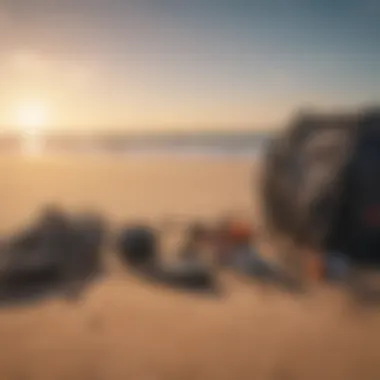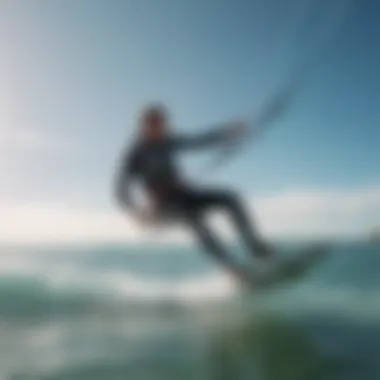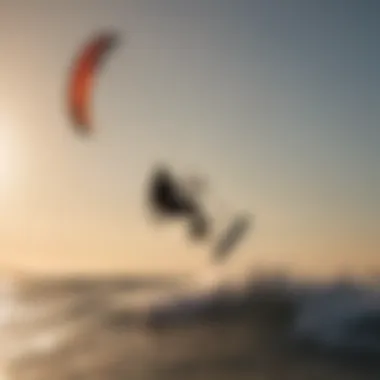Master the Art of Kitesurfing and Kiteboarding: A Comprehensive Guide for Enthusiasts


Equipment Reviews
Kitesurfing and kiteboarding enthusiasts constantly seek the latest advancements in equipment to enhance their performance on the water. In the realm of kites, a detailed overview of the latest models is crucial. Exploring different shapes, sizes, materials, and brands allows riders to make informed decisions based on their skill level, riding style, and local conditions. Understanding the key features and performance attributes of kites is paramount to optimizing the riding experience.
When it comes to kiteboarding boards, riders have a plethora of options at their disposal. From versatile twintips to specialized directional boards, each design offers unique advantages in terms of ride comfort, control, and maneuverability. Delving into the construction, design elements, and suitability for various riding styles provides riders with the knowledge needed to select a board that complements their skill set and preferences. The right board can greatly impact stability, speed, and handling on the water.
Accessories play a vital role in ensuring a safe and enjoyable kiteboarding experience. Harnesses, lines, pumps, and safety gear are among the essential accessories that riders should prioritize. Understanding the importance of each accessory, including their functions and how they contribute to overall safety and performance, is key. Properly selecting, maintaining, and using accessories can make a significant difference in comfort, control, and safety while out on the water.
Travel Destinations
Kitesurfers and kiteboarders are constantly in pursuit of the perfect spot to harness the wind and waves. Popular destinations worldwide attract riders with ideal wind conditions, varying water textures, convenient amenities, and nearby attractions. Highlighting these top spots offers insight into what makes them appealing to riders of all levels. Familiarizing oneself with the nuances of each location can help riders plan unforgettable kitesurfing experiences.
For those seeking adventure off the beaten path, undiscovered kitesurfing gems provide a unique and intimate connection with nature. Venturing beyond the typical tourist locales unveils hidden treasures where riders can immerse themselves in untamed beauty and solitude. Exploring lesser-known destinations offers a chance to escape the crowds and revel in the raw essence of kitesurfing, surrounded by unspoiled landscapes and tranquil waters.
Techniques and Tutorials
Mastering the art of kitesurfing and kiteboarding requires a gradual progression from beginner basics to advanced skills. Novices can benefit from step-by-step tutorials focusing on fundamental techniques like launching, riding, turning, and landing. Building a strong foundation in these essentials lays the groundwork for safe and enjoyable riding experiences. Clear instructions and visuals aid in skill development and confidence building.
As riders progress in their abilities, delving into advanced maneuvers becomes an exciting challenge. Jumps, tricks, wave riding, and freestyle techniques elevate the riding experience, pushing riders to new heights of skill and creativity. Detailed instructions, practice tips, and safety considerations for advanced skills empower riders to expand their repertoire and strive for mastery in their chosen disciplines.
Safety Guidelines
Venturing into the dynamic waters of kitesurfing and kiteboarding necessitates a keen understanding of safety protocols. Weather conditions play a pivotal role in determining the feasibility of a session, with wind, currents, tides, and weather patterns requiring careful assessment. Educating riders on how to interpret and adapt to changing conditions is essential for mitigating risks and ensuring safe outings on the water.
In the event of emergencies, having comprehensive knowledge of rescue tactics and emergency procedures can be a literal lifesaver. Understanding common mishaps and accidents that may occur while kitesurfing enables riders to respond swiftly and effectively. Emphasizing the importance of regular equipment maintenance, checks, and safety gear inspections fosters a culture of safety consciousness among riders, reinforcing the commitment to a safe and enjoyable kitesurfing and kiteboarding experience.
Introduction to Kitesurfing and Kiteboarding
Kitesurfing and kiteboarding are exhilarating water sports that have gained popularity worldwide. In this comprehensive guide, we will delve into the fundamentals of these sports, discussing the essential equipment needed, basic techniques for control, safety measures, and the differences between kitesurfing and kiteboarding. Whether you are a novice looking to start your journey or an experienced rider aiming to refine your skills, this guide aims to provide key insights to enhance your kitesurfing and kiteboarding experience.
History and Evolution of Kitesurfing


The Origins of Kitesurfing The origins of kitesurfing can be traced back to the late 1970s and early 1980s when pioneers such as Legaignoux brothers introduced the first inflatable kite design. This revolutionary invention laid the foundation for modern kitesurfing, combining elements of surfing and windsurfing. The agility and maneuverability of the kite allowed riders to harness the power of the wind effectively, propelling them across the water with speed and precision. The origins of kitesurfing marked a significant shift in water sports, offering enthusiasts a unique way to ride the waves and experience a thrilling adrenaline rush.
The Evolution of Kite Design The evolution of kite design has been rapid and innovative, with continuous advancements in materials and aerodynamics. From the development of delta and bow kite shapes to the introduction of hybrid and foil kites, kite design has become more specialized to cater to various riding styles and weather conditions. The evolution of kite design has greatly enhanced performance, providing riders with greater control, stability, and lift during jumps and maneuvers. Riders can now choose from a wide range of kites optimized for freestyle, wave riding, or racing, depending on their skill level and preferences.
Impact of Technology on Kitesurfing The impact of technology on kitesurfing has revolutionized the sport, making it more accessible and safer for riders of all levels. Advancements in materials such as ripstop nylon and carbon fiber have improved the durability and performance of kites, ensuring reliability in challenging conditions. Innovative safety features like quick-release systems and depower mechanisms have enhanced rider control and emergency response, reducing the risk of accidents. Additionally, technology has facilitated the development of weather forecasting apps and GPS tracking devices, allowing riders to assess conditions and track their progress effectively. Overall, technology has elevated the kitesurfing experience, making it more dynamic, engaging, and secure for enthusiasts.
Advanced Techniques and Tips for Riders
Mastering advanced techniques and tips plays a crucial role in elevating one's kitesurfing or kiteboarding skills to the next level. In this extensive guide to mastering the art of kitesurfing and kiteboarding, delving deep into advanced techniques is essential for enthusiasts looking to enhance their performance on the water. By focusing on refining skills and embracing new challenges, riders can experience heightened levels of excitement and mastery in these dynamic water sports.
Mastering Turns and Transitions (Carving Techniques)
Carving techniques are integral to mastering smooth and controlled turns while riding the waves. The key characteristic of carving techniques lies in their ability to carve sharp and precise turns with agility and finesse. This technique is a popular choice among experienced riders for its effectiveness in navigating challenging waters and maximizing speed and performance. The unique feature of carving techniques is their versatility, allowing riders to adapt their turns to varying conditions with ease.
Mastering Turns and Transitions (Transitioning Smoothly)
Transitioning smoothly between turns is essential for maintaining fluidity and momentum in kitesurfing and kiteboarding. The key characteristic of smooth transitions is the seamless shift from one maneuver to another without losing speed or stability. This technique is a beneficial choice for riders aiming to enhance their riding style and efficiency on the water. Smooth transitioning offers riders greater control and precision when navigating through different tricks and maneuvers, contributing to an overall polished and professional riding experience.
Jumping and Air Tricks (Basic Jumping Techniques)
Mastering basic jumping techniques is fundamental for riders seeking to add aerial maneuvers to their repertoire. The key characteristic of basic jumping techniques is their emphasis on achieving height and hang time while performing jumps. This technique is a popular choice among thrill-seekers looking to add a dynamic element to their riding style. The unique feature of basic jumping techniques is their accessibility to riders of varying skill levels, making them a versatile and engaging aspect of kitesurfing and kiteboarding.
Jumping and Air Tricks (Advanced Tricks and Maneuvers)
Exploring advanced tricks and maneuvers opens up a world of creativity and excitement for riders pushing their limits in kitesurfing and kiteboarding. The key characteristic of advanced tricks and maneuvers is the combination of precision, skill, and flair required to execute complex aerial stunts. This technique is a beneficial choice for experienced riders looking to showcase their expertise and style on the water. The unique feature of advanced tricks and maneuvers is the thrill and satisfaction of successfully pulling off challenging moves, adding depth and excitement to every session on the waves.
Riding Waves Like a Pro (Wave Riding Fundamentals)
Mastering the fundamentals of wave riding is essential for kitesurfers and kiteboarders aiming to seamlessly navigate through varying wave conditions. The key characteristic of wave riding fundamentals is the ability to read waves, anticipate swells, and position oneself strategically for optimal performance. This technique is a popular choice among riders seeking to harness the power and energy of the waves to enhance their overall riding experience. The unique feature of wave riding fundamentals is the connection it fosters between rider and nature, creating a harmonious and exhilarating interaction with the elements.
Riding Waves Like a Pro (Wave Selection and Navigation)


Understanding wave selection and navigation is key to maximizing the potential of each wave and optimizing one's ride on the water. The key characteristic of wave selection and navigation is the strategic decision-making process involved in choosing the right waves to ride based on size, shape, and intensity. This technique is a beneficial choice for riders seeking to challenge themselves on different wave conditions and improve their wave-riding skills. The unique feature of wave selection and navigation is the thrill of confidently maneuvering through waves with precision and control, resulting in a dynamic and captivating riding experience.
Exploring Exotic Kitesurfing Destinations
Exploring Exotic Kitesurfing Destinations within the context of this detailed guide plays a pivotal role in broadening the horizons of kitesurfing enthusiasts. Delving into different kitesurfing locations worldwide not only offers variety but also exposes riders to diverse climates, water conditions, and cultural experiences. By exploring exotic destinations, kitesurfers can enhance their skills, push their limits, and create unforgettable memories.
Top Destinations Worldwide
Thrilling Spots in the Caribbean
Thrilling Spots in the Caribbean stand out as magnets for kitesurfing enthusiasts due to their consistent wind conditions, crystal-clear waters, and picturesque settings. The adrenaline rush that comes from challenging the waves in renowned spots like Turks and Caicos or Barbados is unmatched. Kitesurfers flock to the Caribbean for its warm hospitality, stunning beaches, and a vibrant atmosphere that complements the thrill of the sport.
Hidden Gems in Southeast Asia
Hidden Gems in Southeast Asia offer a different allure, with lesser-known locations like Mui Ne in Vietnam or Siargao in the Philippines providing a more laid-back kitesurfing experience. These destinations immerse riders in rich local cultures, serene landscapes, and unspoiled natural beauty, making them ideal for those seeking a tranquil yet exhilarating kitesurfing escape.
Challenging Waves in Australia
Australia's Challenging Waves serve as a playground for experienced kitesurfers looking to test their skills in rougher waters. Locations such as Margaret River in Western Australia or Airlie Beach in Queensland offer a blend of powerful winds and diverse wave conditions, attracting thrill-seekers and wave enthusiasts alike. Kitesurfers venturing to Australia can expect a mix of challenging conditions, breathtaking scenery, and a vibrant kitesurfing community.
Travel Tips and Recommendations
Packing Essentials for Kitesurfing Trips
Packing Essentials for Kitesurfing Trips encompass crucial items like kites, boards, harnesses, wetsuits, sunscreen, and first aid kits. It is imperative for kitesurfers to pack light yet efficiently, considering factors like airline baggage restrictions and the need for quick assembly and disassembly of gear. Choosing the right kite size for the destination's wind conditions and having backup equipment can make or break a kitesurfing trip.
Choosing the Right Accommodation
Selecting the Right Accommodation plays a vital role in ensuring a comfortable and convenient kitesurfing experience. Proximity to kitesurfing spots, facilities for gear storage and maintenance, and access to local amenities are key considerations when choosing accommodation. Whether opting for beachfront villas, eco-friendly resorts, or budget-friendly hostels, kitesurfers must prioritize safety, comfort, and convenience in their accommodation choices for a seamless and enjoyable kitesurfing trip.
Gear Reviews and Maintenance Guidelines


Gear reviews and maintenance guidelines hold a pivotal role in mastering the art of kitesurfing and kiteboarding. As enthusiasts delve into these exhilarating sports, ensuring they have the right gear and maintain it properly is crucial for performance and safety on the water. This article segment focuses on providing in-depth insights into essential equipment and best practices to prolong the lifespan and efficiency of kitesurfing gear.
Must-Have Gear for Kitesurfing Enthusiasts
Kite Selection Guide
The kite selection guide is an indispensable aspect of kitesurfing equipment for enthusiasts of all levels. By understanding the key characteristics of kites based on factors like size, shape, and wind range, riders can optimize their performance on the water. This guide not only aids in choosing the most suitable kite for different conditions but also contributes to overall safety and control during kitesurfing sessions. Exploring the unique features of each kite design enables riders to make informed decisions tailored to their skill level and riding preferences, enhancing their experience on the waves.
Board Options for Different Riding Styles
The board options available for various riding styles play a vital role in kitesurfing and kiteboarding performance. Different board shapes, lengths, and flex patterns cater to the diverse preferences and skill levels of riders, allowing them to excel in specific riding conditions. Highlighting the key characteristics of each board type assists enthusiasts in selecting the most beneficial option for their individual style and progression goals. Understanding the advantages and disadvantages of different board designs further empowers riders to navigate waves with confidence and finesse, elevating their overall proficiency in these dynamic water sports.
Essential Maintenance Practices
Cleaning and Care Tips
Effective cleaning and care tips are essential for maintaining kitesurfing gear in optimal condition. By following recommended cleaning techniques and regular maintenance routines, enthusiasts can prolong the lifespan of their equipment and ensure peak performance during rides. Highlighting key characteristics such as specific cleaning agents, storage practices, and inspection protocols, this article emphasizes the importance of proper care for kitesurfing gear. Describing unique features like UV protection methods and repairs for wear and tear issues offers readers comprehensive guidance on preserving their equipment's quality and functionality.
Storage Recommendations
Proper storage recommendations are critical for safeguarding kitesurfing gear when not in use. By outlining key characteristics such as climate-controlled storage options, protective covers, and hanging techniques for kites and boards, enthusiasts can prevent damage and prolong the longevity of their equipment. Understanding the advantages and disadvantages of various storage solutions enables riders to make informed decisions based on their available space and environmental conditions. Implementing recommended storage practices ensures that kitesurfing gear remains in top condition, ready for thrilling adventures on the water.
Safety Precautions and Emergency Preparedness
In the world of kitesurfing and kiteboarding, safety precautions and emergency preparedness are paramount aspects that every enthusiast must prioritize. Understanding and implementing effective safety measures can make a crucial difference in ensuring a secure and enjoyable kitesurfing experience. By focusing on these specific elements, enthusiasts can mitigate risks, prevent accidents, and enhance overall safety protocols. Being aware of weather conditions, equipment maintenance, and proper training are all vital components of safety precautions in kitesurfing and kiteboarding. Striving for a balance between adventure and caution is key to mastering these dynamic water sports.
Risk Management Strategies
Assessing Weather Conditions
Assessing weather conditions plays a pivotal role in risk management strategies within the realm of kitesurfing and kiteboarding. Understanding wind patterns, tide changes, and potential weather hazards are essential for making informed decisions before hitting the water. By grasping the unique features of weather assessment, enthusiasts can identify optimal conditions for safe and enjoyable sessions. The ability to interpret weather forecasts accurately empowers riders to assess the feasibility and risks associated with their kitesurfing adventures.
Emergency Protocols
Emergency protocols serve as a critical component of ensuring swift and effective responses to unforeseen situations on the water. Establishing clear emergency procedures, communication channels, and rescue techniques can be life-saving in times of crisis. Having a thorough understanding of emergency protocols equips riders with the knowledge and confidence to handle emergencies calmly and efficiently. While no one anticipates emergencies, being prepared can make a significant difference in ensuring the well-being of oneself and fellow riders.
First Aid Basics for Kitesurfers
First aid basics for kitesurfers encompass understanding common injuries and appropriate treatment procedures to provide immediate care when needed. Recognizing common kitesurfing injuries such as cuts, bruises, and strains enables riders to respond promptly and effectively. By having a grasp of basic first aid techniques, kitesurfers can address injuries on the spot before seeking professional medical assistance. Additionally, mastering rescue techniques is invaluable in scenarios where swift action is required to ensure the safety and well-being of individuals in distress. Learning and practicing these fundamental first aid skills can make a significant difference in handling emergencies effectively during kitesurfing adventures.







